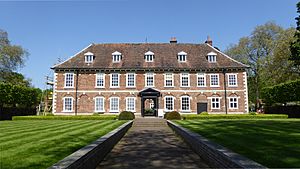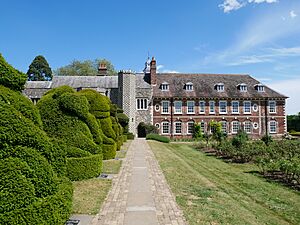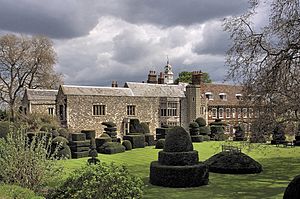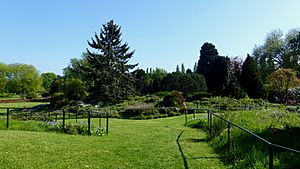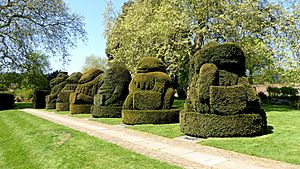Hall Place facts for kids
Quick facts for kids Hall Place |
|
|---|---|
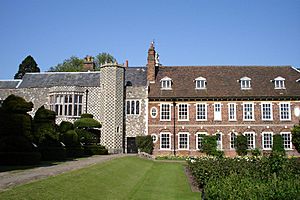
This picture clearly shows the contrast between the 16th-century stone half of Hall Place, and the 17th-century brick half
|
|
| Location | Bourne Road, Bexley |
| OS grid reference | TQ5014574318 |
| Area | London Borough of Bexley |
| Built |
|
| Governing body | Bexley Heritage Trust |
| Official name: Hall Place | |
| Designated | 1 May 1948 |
| Reference no. | 1001985 |
|
Listed Building – Grade I
|
|
| Official name: Hall Place | |
| Designated | 1 October 1953 |
| Reference no. | 1188277 |
| Official name: Hall Place | |
| Designated | 1 October 1987 |
| Reference no. | 1000247 |
| Lua error in Module:Location_map at line 420: attempt to index field 'wikibase' (a nil value). | |
Hall Place is a grand historic home in the London Borough of Bexley in south-east London. It was first built in 1537 for Sir John Champneys, who was a rich merchant and a former Lord Mayor of London.
About 100 years later, in 1649, a man named Sir Robert Austen bought the house and made it much bigger. This is why the house looks like two different buildings joined together! One half is made of stone, and the other is made of red brick.
Today, Hall Place is a Grade I listed building, which means it's a very important historic site. It is surrounded by 65 hectares of beautiful, award-winning gardens that are open for everyone to enjoy.
Contents
The Story of Hall Place
How Hall Place Was Built
The story of Hall Place begins in 1537. A wealthy merchant named Sir John Champneys decided to build a magnificent home. He used stones from a nearby monastery, Lesnes Abbey, that was no longer in use.
Sir John's house had a large Great Hall in the center. The walls were built in a cool checkerboard pattern using flint and other stones. This style was very popular in the 1500s.
In 1649, the house was sold to another rich merchant, Sir Robert Austen. He wanted a bigger home, so he added a whole new section made of red bricks. He didn't try to make the new part match the old part. This created the unique look Hall Place has today.
New Owners and a School
The Austen family owned Hall Place until the middle of the 18th century. It was then bought by Sir Francis Dashwood, a well-known politician. Hall Place was just one of his many properties.
Starting in 1795, Hall Place was leased out and became a school for young boys.
In the 1870s, Sir Francis's grandson, Maitland Dashwood, made some big changes. He hired an architect to add beautiful wood paneling and shiny parquet floors inside the house. He also had the house connected to the main water supply.
During the late 19th and early 20th centuries, the house was rented by several fashionable and wealthy people. The last person to live in Hall Place was Lady Limerick. She lived there by herself from 1917 to 1943 and added some old-fashioned-looking fireplaces and beams.
A Secret Wartime Mission
During World War II, Hall Place played a secret role. In 1944, a special unit of the U.S. Army arrived. They set up a secret radio station inside the house to listen to coded messages from the German Air Force. This was part of the famous Ultra code-breaking operation.
The soldiers turned the Tudor Kitchen and Great Hall into radio rooms. They filled them with tables and radio equipment. Wires for the radio antennas were even stretched across the roof! The Great Parlour, a fancy sitting room, became a bedroom for the soldiers.
After the war, the house was used as part of a local school for girls. Later, from 1968 to 1995, it was the main office for Bexley's libraries and museums.
Hall Place and Gardens Today
Today, Hall Place has been carefully restored to look like it did in the 16th and 17th centuries. It is managed by a charity called Bexley Heritage Trust, which takes care of the house and gardens for visitors.
The trust has made many improvements, including adding a café, a visitor center, and classrooms. An old stable building from the 17th century has been turned into an art gallery. The gallery shows artwork by local artists.
The Amazing Gardens of Hall Place
The gardens at Hall Place are a major attraction. They cover 65 hectares and include many different areas to explore, such as:
- A topiary lawn
- A herb garden
- A tropical garden
- Long flower borders
The gardens first opened to the public in 1952.
The Queen's Beasts
One of the most famous parts of the garden is the topiary display called the Queen's Beasts. These are bushes and trees trimmed into the shapes of amazing animals. They were planted in 1953 to celebrate the coronation of Queen Elizabeth II.
What Else Can You See in the Gardens?
The old walled gardens are now home to a tropical butterfly house and an owl sanctuary.
There are also many special trees in the grounds. You can find an Indian Bean Tree, a giant Redwood tree, and a Black Poplar tree. The Black Poplar was planted in 2012 to celebrate the Queen's Diamond Jubilee.
The gardens have won a Green Flag Award for over 20 years in a row. This award recognizes that the gardens are kept to a very high standard.


